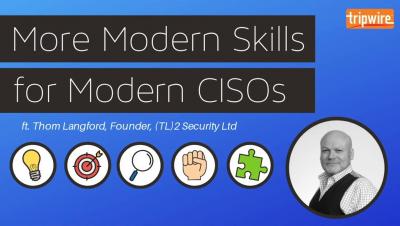Security | Threat Detection | Cyberattacks | DevSecOps | Compliance
Tripwire
Leadership Through Security: The Changing Role of the CISO
The traditional career path for a chief information security officer (CISO) is fairly straightforward. An individual begins their career in IT but ultimately moves to security after demonstrating a security mindset. Once established within the ranks of information security, the professional receives promotion after promotion until they attain the title of CISO.
Ransomware, Phishing, and Supply Chain the Most Significant Threats to UK Businesses
Trend analysis is an important topic within threat intelligence. It lets us forecast where things are headed; whether they’re getting better, worse or different; and where we should be focusing our precious budgets. The UK’s National Cyber Security Centre (NCSC) recently released the Incident trends report (October 2018 – April 2019). This highlights some of the trends seen across various UK government entities, organizations and sectors.
HITRUST and Tripwire Partner to Help Healthcare Organizations Mature their Cybersecurity Practices
Cyberattacks in the healthcare industry show no signs of abating. In 2018, 15 million healthcare records were breached. Alarmingly, in the first half of 2019 alone, 32 million healthcare records were compromised as a result of multiple incidents including the American Medical Collection Agency (AMCA) breach. At AMCA, 24 million patient records were affected when an unauthorized user accessed systems that contained sensitive information like SSN, provider names and medical information.
Modern Skills for Modern CISOs: Your Questions Answered
Sometimes your best intentions are thwarted by technology. That was the case when Thom Langford and I attempted to do a Q&A session after our webinar “Modern Skills for Modern CISOs.” Unfortunately, the session ended before we got the chance to answer the questions that the audience had submitted. The silver lining is that we had the chance to write our answers thoughtfully instead of answering them on the spot.
Modern Skills For Modern CISOs
Is the Electric Grid Ready to Respond to Increased Cyber Threats?
Reports from the U.S. Government Accountability Office (GAO) and Siemens highlight both the increasing cyber threats faced by the electric utility companies and the lack of adequate readiness to respond to these threats. According to these reports, a cyber-attack on the electric grid could cause “severe” damage.
Modern Skills for Modern CISOs, Part 2 ft. Thom Langford
Guide to Container Security - Everything You Need to Know
Ah, the wonders of technology. In the innovation-rich Information Age, we are the beneficiaries of a nonstop wave of new advancements, each offering the ability to execute vital tasks faster and more efficiently than ever before. However, along with each breakthrough comes potential security vulnerabilities.
Cyber Attack Risk Climbs in Latest WEF Regional Risk Report
Unsurprisingly, cyber attacks are growing in the business sector and not just in the United States but world-wide. Cyber-attacks represent the greatest risk in six out of ten of the top economies in the world. The report presented by the World Economic Forum discusses formjacking, cryptojacking, ransomware like LockerGoga and other cyber-attacks of which CEOs around the globe are starting to become more aware.





